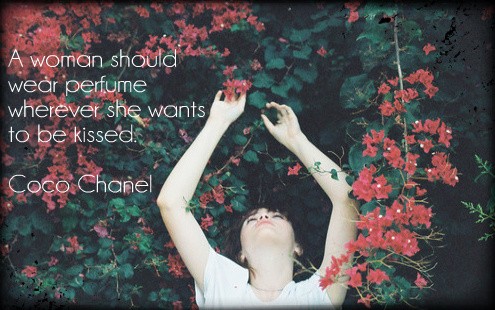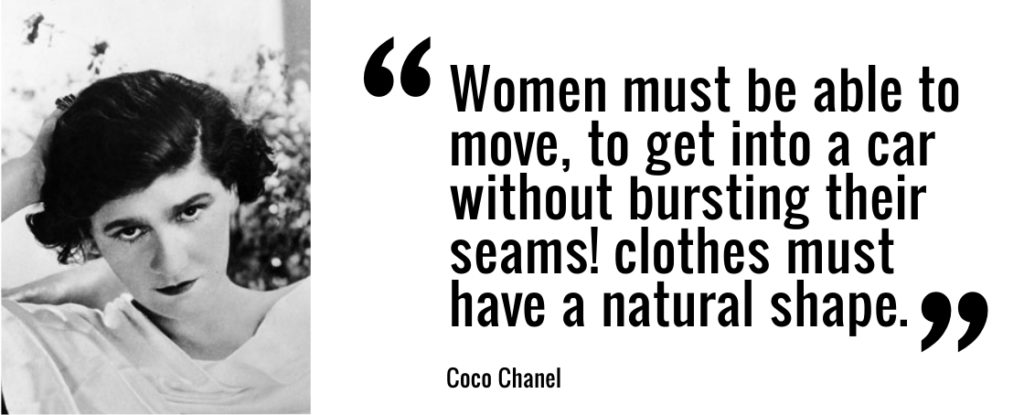Abandoned orphan. Cocotte (kept woman) and Couturière. Nazi-lover?
Gabrielle Bonheur Chanel did not live an easy nor uncontroversial life. Her parents: mother Jeanne, a landrywoman, and father Albert Chanel, a traveling street vendor, were unmarried at the time of her birth, though persuaded (shotgun marriage?) to formally wed, several children later. When Gabrielle was 12, her mother died; she and her two surviving sisters were sent to the convent of Aubazine in Central France, while the two boys were sent to work as farm laborers.
Later, when Gabrielle “aged out” of the convent at age 18, she (and her sisters?) found work as seamstresses (having been trained in sewing by the nuns) during the day, and sang and danced in La Rotonde, as a poseuse, one of the performers who entertained between star turns. As shown in the clip, below, from the movie Coco Before Chanel, the pavilions were dark, crowded, noisy venues.
It is thought to be here that Chanel picked up the nickname Coco, perhaps from one of the popular songs she frequently performed.
To advance, the girls had to present considerable talent, to move up to a star position. Another option was to attract a protector.
Coco did not have the singing or dancing talent to move to a star position.
She did, however, succeed in attracting the interest of ex-calvalry officer, textile heir Étienne Balsan, and lived with him in his chateau, Royallieu for the next three years.
A Child is Born
Julia-Berthe, Coco’s older sister, is supposed to have married, given birth, and committed suicide when the boy, André Palasse, was six. Whereupon Coco adopted the boy, and promptly shipped him off to boarding school in England.
But there were persistent rumors that the boy belonged not to Julia, but to Coco, probably by Balsan. In any event, Coco did not bear any (other) children, so Palasse would become her sole heir, and perhaps, her most important emotional connection, outside of “Boy” Capel.
Enter Boy Capel – Lover, Sponsor, Muse
While living with Balsan, Coco would fall in love with and “run away with” his friend Captain Arthur “Boy” Capel, a member of the English aristocracy. He established Coco in a Paris apartment, and would finance the fashion boutiques Coco opened in Paris, Deauville, and Biarritz.
At a time when women’s fashions imprisoned, even distorted women’s bodies in tight corsets and many yards of stiff, fussy fabric, Chanel’s designs were revolutionary and boasted simple, clean lines. They used fabric like jersey that breathed, and moved, and allowed women to breathe, and move. They were modeled upon men’s fashions, in large part, those seen and admired by Coco upon her lover, Boy Capel.
It didn’t hurt that these styles were also most flattering to Chanel’s own lean, athletic, boyish figure.
Fashionable women couldn’t get enough. To Capel’s surprise, Chanel repaid all the amounts he had “loaned’ her (most men at that time considered such loans to a mistress to be a gift) in a short period of time.
And then Capel was killed, in an auto accident in 1919. Never mind that he had married, elsewhere; never mind that Chanel herself had taken other lovers. Twenty-five years later Chanel would refer to his loss as “losing everything.”

The Parfum That Launched a Thousand Affairs
Having launched a successful clothing brand, Chanel branched out into scents.
Traditionally, women’s fragrances around 1920 were either single floral notes (for respectable women) or heavy, musky aromas. Working with parfumier Ernest Beaux, who for the first time used aldehydes in the process, Chanel is said to have selected the fifth vial (of ten) as the mix she sought.
In 1921, Chanel launched her signature fragrance, Chanel No 5, which included oils of jasmine and tuberose. Depending on who told the story, the “invisible” flask would be based upon either the men’s toiletry bottles Boy used, or perhaps his alcohol decanters.
In any event, the sales of Chanel No. 5 would make Chanel a very, very rich woman, even if it would make her partners in the endeavor even richer. Pierre and Paul Wertheimer would finance, produce, market and distribute Chanel No. 5, for 70%, and Theophile Bader, founder of the Galeries Lafayette department store, would receive 20%. During WWII, Chanel would become unhappy with her 10% (especially as the Wertheimers had moved its manufacturing to America, and were not originally sharing the worldwide sales) and she would try to seize greater control of the company.
The Only Thing She Sewed Up Was Her Designs
Even though Boy Capel was the great love of her life, Coco did not stop being a sexually active women involved with other men, even before his death, let alone afterwards. Many lovers were famous, such as Igor Stravinsky, the Duke of Westminster (English), Grand Duke Dmitri Romanov (Russian), poet Pierre Reverdy, illustrator Paul Iribe. Some say she had more than a close friendship with the Prince of Wales (later to abdicate his throne for American divorcee Wallis Simpson). She maintained a lifelong friendship with Winston Churchill, as well. Some claim her friendship with Misia Sert, wife of Spanish painter Jose-Maria Sert, included a sexual element.
Almost all of her lovers remained friends and admirers for the rest of their lives. In cases where they were or became indigent, she would often support them (and their families) in their declining years.
Somehow, Chanel also found time to continue her work as a designer, clothing that not only bore her elegantly simple and distinctive logo, but a very distinctive “look” that women all over the world wanted to wear. Unlike other designers, Coco was happy to let her designs be copied by others, correctly understanding that this only created a greater desire for the real items. She also designed jewelry, and a handbag that is still famous today,
But What About the Nazi Years?
What has come to light in recent years is Chanel’s early involvement with the Nazi party. While she was called before French investigators to answer allegations more than once, she was always freed – due to Winston Churchill’s influence, is one rumor, due to lack of evidence was the reason given.
What is undeniable is that:
- Chanel spent six of her formative years in a Catholic convent at a time when the Catholic Church was virulently anti-Semitic.
- Her lover and fiance Paul Iribe wrote and published (with Chanel’s funding) a magazine that quite frequently ran articles about how France was being destroyed from within by the Jews.
- Her lover the Duke of Westminster also made frequent anti-Semitic statements.
- She was able to continue to live at The Hotel Ritz when most Parisian tenants were evicted from it to make room for German officers (although she did have to change apartments).
- She took as her (younger) lover during those years a professional German spy, Baron von Dincklage.
- Her nephew (son?), André Palasse, was a prisoner in a German POW camp, later released.
- She engaged in a bizarre attempt to end the war that was called Operation Modelhut and involved her and her connection Vera Bate Lombardi, and a trip to Madrid, Spain.
- The chief of SS intelligence, General Walter Schellenberg, was convicted at Nuremberg of war crimes, but released in 1951 with incurable liver disease. Chanel paid for his and his family’s living expenses and medical care, and for his funeral.
This has been one of the hardest “Slut” pieces to write, because the idea of anyone willingly, knowingly, cooperating with the Nazi’s and/or Hitler’s “Final Solution” makes me want to puke.
However… I have learned that history is flexible, and historians and biographers bring their own baggage into their view of a subject. They can prove that Chanel cooperated with the Nazis, and had a Nazi officer as her lover. They can – and do – explain WHY they think she did that, but neither they – nor we – can see into her mind to really know.
My book club has been reading a number of WWII-themed books in the last few years, from The Book Thief to The Girl You Left Behind, plus several more, and I have come to understand better that sometimes people do what seems like horrible things on the outside, for what are internally admirable motives, like the French woman in Girl who pairs up with a German officer and acts as a double agent, sneaking in supplies and news, even though she is despised and spit upon by the people in her village.
My personal opinion is that Chanel admired the Nazi Party and disliked Jews, except for her own particular friends, just as people can be racist and have black friends. She felt that the Nazi system of government was better than the communism/Bolshevik revolution in Russia, for France, and bore a grudge against the Westheimers (more Jews!) for what she perceived as cheating her.
However, It is also possible that Chanel was biting her tongue till it bled when her lovers made anti-Semitic comments. That she did what she did during the occupation and war to safeguard the life of her nephew, André Palasse.
Or, it is possible, she was simply determined to survive, and always “went” with what she perceived to be the winning team, without having any personal philosophy at all. Can any of us say, for sure, what Chanel felt, and why she did what she did?
Last March Down the Runway
In 1954, after a 15 year absence, Chanel returned to couture with a new collection. Paris felt it was the same old, same old… and while to a certain extent England and America did too, they also loved classic Chanel, and made it a financial success.
Coco Chanel lived to be 87, dying at The Hotel Ritz in 1971. Despite her early life of poverty and struggle, despite living through two World Wars, a long-standing morphine addiction, death of lovers and friends, and so much more, she achieved some amazing gains for women through her work. Even as I despise what I believe to be her Nazi-loving activities, I cannot help but concede and admire the way her bold and innovative fashion creations helped women stride into more freedom, of body and thought. Would the women’s liberation movement have happened when it did, if women had still been encased in corsets and acres of ruffles in the 1950’s and 60’s?
About the Great Sluts in History series:
What makes a woman a “slut,” anyway? From Lillith to Jezebel to Sandra Fluke, it seems that whenever women are in positions of power, open about their sexuality, “too outspoken,” or heaven forbid, all three, they are labeled sluts by some men (and sometimes other women), in an attempt to shame them into “knowing their place.” And into meekly accepting “their place.”
This series will look at flawed and wonderful heroines throughout history who insisted on “Following their own weird,” no matter how much it cost them to do so. And how, by doing so, they made the world better for all humans, of all genders, who followed them.
“…it is no longer acceptable to discuss women’s rights as separate from human rights… If there is one message that echoes forth from this conference, let it be that human rights are women’s rights and women’s rights are human rights, once and for all.” ~Hillary Rodham Clinton, 1995
Do you wear any Chanel fragrances or clothing?
Do you think you would like to?
Your thoughts?



